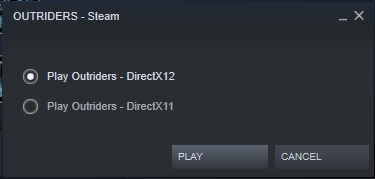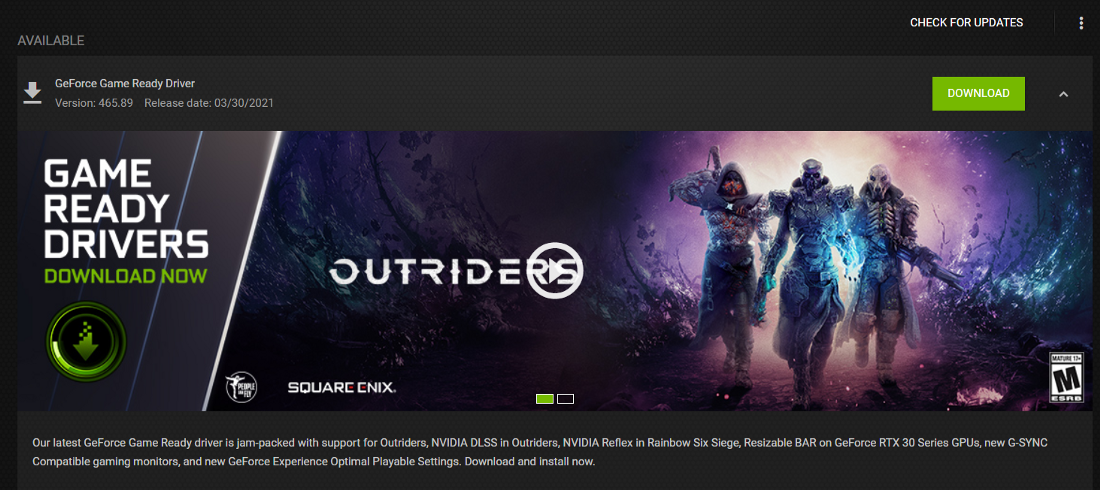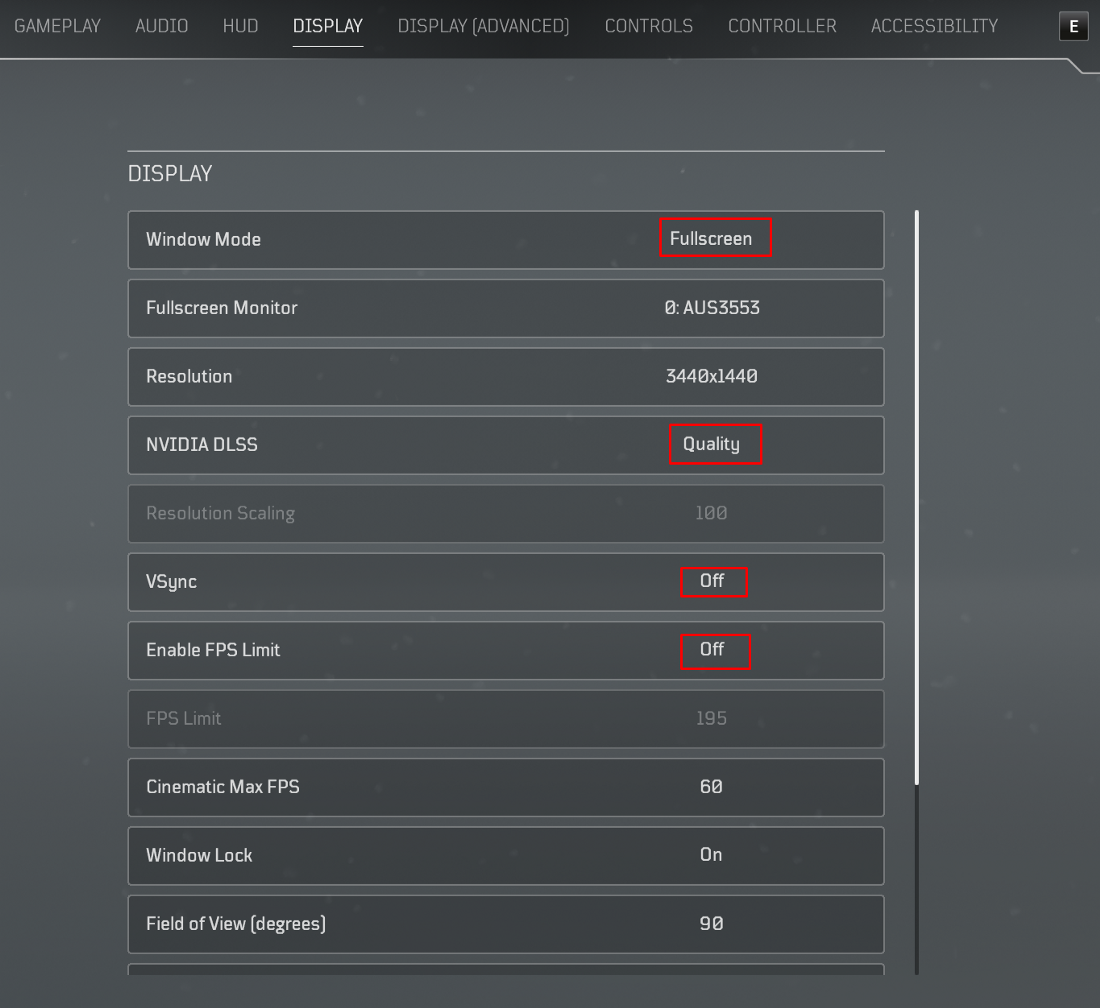Outriders is here! As with any new game that comes out, there are often some performance issues that can become even more noticeable when trying to stream and play at the same time.
Luckily here at Streamlabs, we did some testing and came up with a few settings we recommend that you apply to get the most out of your streaming and gaming experience.
Steam Settings
Please note that we are basing some of this information on issues that users are currently experiencing at the time of this writing. As such, some of this may be subject to change.
DX12 vs DX11 - If you are experiencing issues on DX12, try using DX11. You can switch this by choosing the option when you launch the game from Steam, or adding “-force -dx11” to your Launch Options via the Steam properties menu for the game.


Verify Game Files
Sometimes doing this will fix any odd in game performance issues you are having. You can find this option via the same Properties menu as above.

Disable Steam/Third Party Overlays
GeForce Experience, Steam, Discord, etc., all have in-game overlays that can be disabled to increase performance. In the screenshot above, you would need to untick the “Enable the Steam Overlay while in-game” option. Each application will have its own instructions for turning off the in-game overlay.
It’s also a good idea to go to your Game Bar and turn off the ability to record clips, take screenshots, and broadcast. Any background processes may have a negative impact on performance both on the game and your streaming software.

Update Drivers
If you haven’t already, it’s a good idea to keep your drivers up-to-date. If you have an NVIDIA GPU, open GeForce Experience and install the latest driver update.

Windows Settings
Windows Security — If you are experiencing stuttering issues with DX12, this should resolve that.
Open Window Security and click “Virus and Threat Protection”

Then click “Manage Settings” under Virus and Threat protection settings

Click “Add or Remove Exclusions”

Add both folders to the exclusion list

C:\Users\Username\Appdata\Local\Madness
C:\SteamLibrary\steamapps\common\OUTRIDERS
(Your drive letter may be different which is fine.)
In-Game Settings
Optimizing your in-game settings helps to ensure that your stream and game run smoothly. You may need to do some testing to find the right settings for your setup, but these are our guidelines.

Display Settings:
Window Mode — Full Screen
NVIDIA DLSS — Quality (This can be changed to suit your needs, but quality seems to provide the most benefit.)
Vsync — Off
Enable FPS Limit — Off (Normally capping your FPS is a good thing to do when streaming/gaming but currently having this on has a negative effect on performance.)
DX12 — While this is not in the in-game menu (see above info) you should use DX12 if you can for an FPS gain. Use DX11 if you are experiencing issues.
Streamlabs Desktop Settings
Before we jump into the settings you can optimize in Streamlabs Desktop, it’s always a good idea to run your streaming software in administrator mode.
Administrator
Right-click your Streamlabs Desktop icon and select “Run as Administrator”. This is good to do regardless of the game as it allows you to take advantage of all of the performance mechanics.

Performance Mode
This will hide your preview to improve overall performance. Enable this by right-clicking your preview screen and selecting Performance Mode.

Auto Optimize
If the settings in your streaming software are too demanding for your computer’s hardware, you will encounter performance issues on your live stream.
For new Twitch streamers, Streamlabs Desktop has an Auto Optimize feature that automatically scans your internet speed and computer hardware to give you our recommended settings.
Access this feature by opening Streamlabs Desktop, navigating to Settings > General. It’s a fantastic way to jump right in without having to mess with the finer details.
If you are more technically savvy, you can adjust settings within Streamlabs Desktop to help ensure optimal quality.
Quality and Resolution
The output of your video resolution can have a significant impact on the quality of your live stream and the performance of Streamlabs Desktop. For example, streaming at 1080p vs 720p will double the number of pixels, meaning your computer will be using more resources.
To adjust your resolution, select “Video” from the side panel in the setting window.

You can leave the base (canvas) resolution as your computer’s native resolution. We recommended lowering the Output (Scaled) Resolution since streaming in 1080p can have a significant impact on your CPU. We recommend lowering the Output (Scaled) Resolution to 1280x720 for a good balance between performance and quality.
Choose your Encoder
When it comes to encoders, there are two types: software (x264) and hardware (NVENC). The software encoder (x264) will use your CPU to encode video, while hardware encoders like NVENC utilize a dedicated encoder in the GPU, allowing you to play and stream without compromising game performance. If you are using an NVIDIA graphics card we recommend you stream with NVENC New.

Change the CPU Usage Preset
To change the CPU usage preset, navigate to “Output” in the settings window.
NVENC presets range from low-latency, optimal performance, and max quality. We recommend starting with the “Quality” preset and experimenting from there to find what works best for you.
x264 offers a range of usage preset. This refers to how fast the CPU encodes video. The faster it encodes, the less CPU it uses. By default, this is set to “Very Fast”, which provides the best balance between performance and quality.

Enable Dynamic Bitrate
In a recent update to Streamlabs Desktop, we included a feature called Dynamic Bitrate. This feature allows our software to automatically adjusts your bitrate based on network conditions to prevent dropping frames.
Remember, if you’re computer and internet speed can’t handle the bitrate you’ve set, you may experience dropped frames, which is an attempt to improve the stability of your stream and minimize latency.

To enable Dynamic Bitrate, navigate to the settings window, and click “Advanced.” Scroll down and toggle the box next to the option that says “Dynamically change bitrate when dropping frames while streaming”.
Edit Bitrate Manually
You can also manually edit your bitrate. Below are Twitch’s own recommend specs for NVIDIA NVENC. We recommend streaming at 720p 30fps to get the best performance out of your streaming software.
1080p 60fps
- Resolution: 1920x1080
- Bitrate: 6000 kbps
- Rate Control: CBR
- Framerate: 60 or 50 fps
- Keyframe Interval: 2 seconds
- Preset: Quality
- B-frames: 2
1080p 30fps
- Resolution: 1920x1080
- Bitrate: 4500 kbps
- Rate Control: CBR
- Framerate: 25 or 30 fps
- Keyframe Interval: 2 seconds
- Preset: Quality
- B-frames: 2
720p 60fps
- Resolution: 1280x720
- Bitrate: 4500 kbps
- Rate Control: CBR
- Framerate: 60 or 50 fps
- Keyframe Interval: 2 seconds
- Preset: Quality
- B-frames: 2
720p 30fps
- Resolution: 1280x720
- Bitrate: 3000 kbps
- Rate Control: CBR
- Framerate: 25 or 30 fps
- Keyframe Interval: 2 seconds
- Preset: Quality
- B-frames: 2
Please remember, everybody’s setup is going to be different so make sure to play around with the settings yourself to find out what works best for you.
If you’re still experiencing issues and need further support, drop by our Discord or submit a ticket.